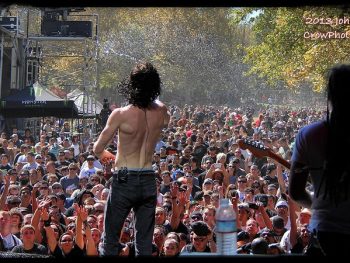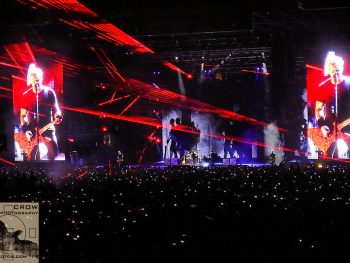I found a typed paper that I had written for P.A. English, Period 2, Mrs. Cohen, entitled “Paralysis Through Analysis – ‘Subdivisions’ by Neil Peart”. Back then, we actually had to use a typewriter, and use white out and a black pen to make any edits. I may have even asked my Mom to type it for me on a Sunday night, since I had waited until the last minute to write it, and she was an expert typist.

“Subdivisions” is a work which concerns itself with the concept of “suburbs” and how living there affects young people during their adolescent years. Lyricist and poet Neil Peart has observed this situation and interpreted it in a concise, imagistic, understandable manner. Mr. Peart uses imagery, figurative language, structure, and tone to convey his thoughts and insights on the subject matter.
In writing “Subdivisions”, Neil Peart used imagery to give his audience a general idea of what life in the suburbs is like; to help them put a more accurate picture in their heads than they might have imagined had he not described the setting. He describes the physical location of suburbs as geometrically stretching out from around the cities. They are somewhere “in between the bright lights and the far unlit unknown” (L.3). They are seen as a cross between the densely populated, action-filled city and the dark, lonely wilderness. In lines 8 through 15, Peart gives the audience a taste of what teenagers do and what they must do to survive in the suburbs. He gives a very powerful, insightful image of life in the suburbs.
The two most prevalent aspects of figurative language in “Subdivisions” are simile and metaphor. The bright lights of the city draw people out of the suburbs “like moths” (L.16). Peart is comparing the fascination people have with cities to the force that compels moths to fly into bright lights. He continues by saying that many must be “lit up like a firefly just to feel the living night” (L.19). This might mean that people have to be “lit up” or somehow awakened out of their dullness to feel life, as a firefly must wait until nighttime before his light can be seen clearly. Metaphor is also used to compare the suburbs to “an insulated border” (L.2) that keeps the city protected from the unknown wilderness and vice versa. Peart also brilliantly rewords and reworks the “rat race” concept to illustrate how people lose when they feel compelled to sell out to get something out of their life. They “get caught in ticking traps” (L.22) from which there is no escape and they start to feel lower than rats.
The structure of this work is used to show various aspects of the central theme while maintaining a continuity of progression. Each section of the work is about the problems and pressures of growing up in a suburban environment. The “characters” in each section progressively get older and face different problems. In the first subdivision, young dreamers and misfits must cope with the pressure of growing up with expectations placed on them, with no one to explain their own feelings and ideas to. The next subdivision deals with high school peer pressure to be like everyone else, or else. Next, older kids must drive into the city to find something exciting to stimulate them. The final subdivision of the story focuses on adults who have been unable to live up to their predecided expectations, and the problems they have handling stress.
The tone Neil Peart has taken in writing “Subdivisions” is multi-faceted. He is critical of the situation many suburbanites have been placed in, but he has written with compassion and sympathy for their “restless plight” (L.23). He has grasped the desperation of some of these people, as evidenced in lines 20 through 24. He shows how they have sold out their big dreams and now are forced to dream the sad, simple dream of going far away where they will be out of the memory of such a peaceful setting as a “lighted street on a quiet night” (L.24). There is great irony in that last stanza.
“Subdivisions” is one of my favorite songs, for many reasons. Even without the expert musical accompaniment of Rush, Neil Peart’s lyrics alone touch me deep inside. The message is totally truthful and incredibly insightful. Most of all, besides the theme, the words themselves are so perfectly chosen. They rhyme in various places and are also alliterative and assonant. Neil Peart is truly a master and he deserves to be recognized as one of the poetic geniuses of his time.
Neil Peart has used imagery, figurative language, structure, and tone to create a picture of life in the suburbs. “Subdivisions” is a work that has captured every aspect of the atmosphere and the essence of suburban life.
Mrs. Cohen’s grade and comments:
Intelligent, insightful and well written.
You demonstrate good understanding of this poem, poetry and writing about poetry.
A.
“Subdivisions” by Rush
Sprawling on the fringes of the city in geometric order
An insulated border
In between the bright lights and the far unlit unknown
Growing up – it all seems so one-sided, opinions all provided
The future pre-decided, detached and subdivided
In the mass-production zone
Nowhere is the dreamer or the misfit so alone
Subdivisions
In the high school halls, In the shopping malls
Conform or be cast out
Subdivisions
In the basement bars, In the backs of cars
Be cool or be cast out
Any escape might help to smooth the unattractive truth
But the suburbs have no charms to soothe the restless dreams of youth
Drawn like moths, we drift into the city
The timeless old attraction
Out cruising for the action
Lit up like a firefly just to feel the living night
Well some will sell their dreams for small desires
Or lose the race to rats
Get caught in ticking traps
And start to dream of somewhere to relax their restless plight
Somewhere out of the memory of lighted streets on a quiet night













 My Life In Music, Part 1, 1969 – 1974
My Life In Music, Part 1, 1969 – 1974